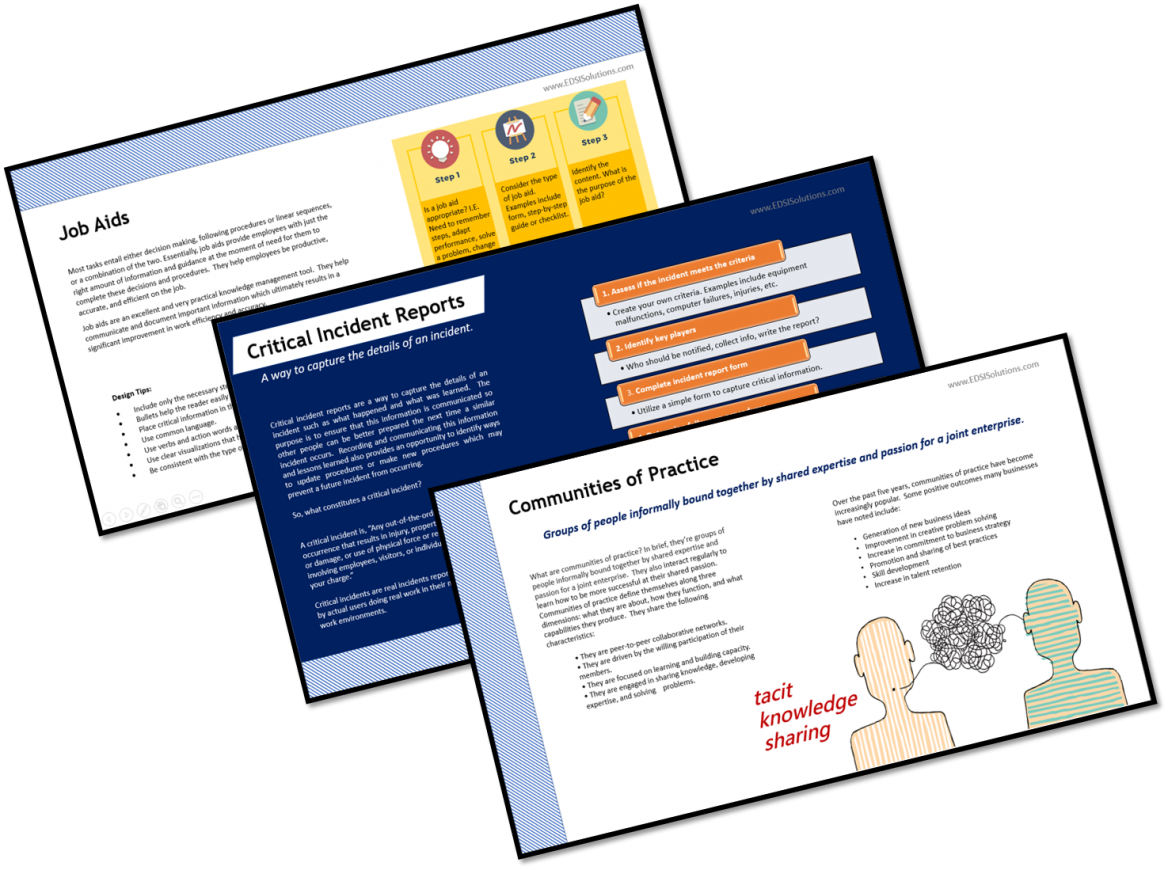The 10-Step Process to Setting Up a Knowledge Management Program
When it comes to knowledge management (KM), not everyone agrees on its definition or value. Some believe KM is a stand-alone program or project, but that is incorrect. Knowledge management refers to the explicit and tacit information life-cycle that runs throughout the entire organization continually.
When implemented based on the right objectives, process clarification, and people incentives, knowledge management:
- Taps into existing expertise and experience
- Enables better and faster decision making
- Provides highly valuable process efficiencies that eliminate redundant efforts
- Encourages communication of important information widely and quickly
- Stimulates innovation and growth
Need more information on knowledge management and the types of knowledge that exist? Before reading further, brush up on the basics of knowledge management and why it’s important to your company.
Why Implement KM?
By setting up a successful KM process, a business can reduce costs, enhance productivity, and improve knowledge sharing processes among teams, managers and employees. KM focuses on managing business critical knowledge and, as a result, it helps improve efficiency and productivity throughout all work stages and managerial levels.
What’s at risk if you don’t implement KM in this ever-changing global economy? HR Magazine reported that Fortune 500 companies are losing up to $31.5 billion a year by failing to share knowledge. By proactively implementing knowledge management systems, companies can improve their chances for success by expediting decision-making, building more efficient learning environments, supporting innovation and inspiring cultural change.
Successful implementation of KM demands an alignment between the strategic objectives of the organization and the process itself. Based on those goals, it makes sense to assess the information, tools and processes required for meeting the company’s knowledge management needs.
The best early steps in the KM process involve strategy, planning, and needs gathering, while later steps focus on implementation and continual development and improvement. The steps listed below will take you seamlessly through setting up a successful knowledge management program.
Step 1: Triage the Crisis
Are you here because of an urgent or immediate need to conduct knowledge management efforts? Has an expert recently left, or are they leaving soon? Have you realized that only one person has critical information?
If lack of KM within the entire organization has given you many pockets of siloed, at-risk tacit knowledge among an individual or department, you need to identify the specific at-risk knowledge, then capture it, and if possible, transfer if before anyone leaves the organization.
Going from crisis to crisis isn’t sustainable, so this isn’t a sustainable KM program. If you’re in a high-risk KM situation, you need to read this article.
If you’re looking to create a long-term sustainable KM Program, continue to step 2 below.
Step 2: Create Knowledge Management Program Objectives (Pilot)
Before defining a process, take the time to visualize and articulate your end goals. What do you hope to accomplish as far as how knowledge is captured, shared and analyzed? Start by comparing existing documentation of knowledge and procedures, and then create a match to the skills and abilities required for optimum performance within your organization. You should be able to:
- Conduct a skills assessment
- Identify skill gaps
- Establish appropriate program objectives
- Document the business problems that need resolution
The best way to start is by writing a list of short-term and long-term objectives that address the business problems and support short- and long-term business goals. Short-term objectives should be able to provide validation that the program is on the right path, while long-term objectives will help to create and communicate the big picture.
For all but the smallest companies, It’s usually going to work better to do these steps for a pilot department or job title, move onto the subsequent steps, then come back to step 1 to apply lessons learned before implementing them organization-wide.
Identifying that pilot department or job title may be informed by who you were working with in the “triage the crisis” step.
Step 3: Prepare for Change
Implementing a new knowledge management program may require changes within the organization's existing practices and shared values; changes that some employees may resist. Many companies decide that the more transparent they are, the better. Seeking out employees at all levels to get their input and views on the strategy, design and execution of intended process changes will maximize the best chance for program success. When it comes to managing cultural change, don’t be too proud to call on experts when necessary to help facilitate and roll out new plans and expectations.
Step 4: Define a High-Level Process
Effectively managing your organization's knowledge assets means you should start to form a high-level knowledge management process that includes detailed procedures and work instructions. Clearly documenting the process and the needs of all the departments involved is essential. Utilization of company-wide interviews, as well as gathering current documentation and procedures will lead to the most thorough analysis and subsequent development of new KM goals that are aligned with the company’s corporate goals.
Organizations that don’t clearly define their KM process are unlikely to fully realize their knowledge management objectives. Having a strong understanding of how knowledge is identified, captured, categorized, and shared will result in the most relevant and applicable end results.
These criteria are most crucial:
You may want to consider creating a dashboard to capture all the important data. Some knowledge management systems can be programmed to analyze the relationships between content, people, topics and activity and then produce a knowledge map report. This is particularly useful for information sharing. The dashboard can serve as an evolving, living document that reflects metrics across the company.
Step 5: Define and Prioritize Technology Needs
Depending on the program objectives established in Step 1 and the process controls and criteria defined in Step 3, you can start to determine and prioritize your KM technology needs. Purchasing new technology may not be necessary at all if your existing technologies are able to meet your needs. You can also hold off on making technology decisions until after the knowledge management program gets off the ground and more specific needs are determined.
Step 6: Assess Current Business State
Once you've accomplished Steps 1-4, you are ready to assess the current state of knowledge management within your organization. You can do that by conducting three different assessments.
- Identify the organizational (or departmental) knowledge gaps- What knowledge does the organization need? What knowledge does it have? Uncovering this information will show you what knowledge is missing. Doing this as a pilot program on a specific department or area to start is ideal.
2. Evaluate current KM program- An analysis can be conducted to identify the current state of practice as it relates to the existing, documented KM practices and procedures. Ask questions such as how do we currently retain and transfer knowledge? What technology do we currently use to help with this effort? This should outline the core knowledge management components: people, processes and technology. This analysis will help you identify which areas of your current KM efforts need focus and improvement.
3. Conduct a knowledge loss risk assessment to identify the total attrition factor. This assessment is designed to identify positions/people where the potential knowledge loss is greatest and most imminent. It involves two factors, time until retirement and criticality of position. Conducting this assessment will help you identify which specific employees would benefit from knowledge capture and retention efforts.
Step 7: Implementation
Implementing a knowledge management program and improving the overall effectiveness of your organization will require significant resources and commitment. You’ll know you’re in good shape when:
- Objectives are clear
- Issues have been anticipated and planned for
- Processes and technologies are in place that will inform and launch your KM program
- Gaps have been defined and you have a roadmap to tell you how to address them
By recognizing and documenting short-term successes through each step of the roadmap, your program’s momentum will remain steady.
Step 8: Assess Effectiveness with “After Action Reviews”
Measuring how much a KM program contributes to business benefits can be a challenge because it deals with intangibles. How do you know your knowledge management program is working?
Accomplishing an organizational shift around knowledge sharing is important, yet represents an organizational shift in culture, which can be difficult to achieve. How are incentives aligned so that people are proactively sharing and documenting instead of gathering unique tacit knowledge for “job security”? How can the outlook shift so that someone who has completely unique tacit knowledge sees that as a liability?
After Action Reviews (AAR) are an effective approach for capturing the knowledge gained from KM initiatives. They involve reviewing a project after it is complete to analyze what happened. From there, you can decide what parts of the process to keep and what to change next time. Check out our ebook for more information on AARs and other knowledge management tools and methods.
When deciding on the appropriate metrics to measure your organization’s progress, be sure to cover these 4 areas:
- Quality
- Value
- Performance
- Compliance
This step is very important because it provides valuable insight into what's working and what's not. You can then take the necessary actions to improve quality, value, performance and compliance gaps, which will improve the overall impact of any knowledge management program.
Step 9: Make Continuous Improvements
Plan to be in a state of continuous improvement with additions and enhancements being made on an ongoing basis. Making use of appropriate new tools and technologies as they become available is key to any successful KM program. A continuous improvement approach to business activities will enable an organization to improve its competitive position either by increasing its revenue through improved relationships with customers or by achieving cost efficiencies through process improvement.
Step 10: Know the Power of Knowledge Management
Implementing a thorough knowledge management plan takes time and money, but the improvements and results are worth it, especially when risks can be minimized. Organizations who make this important investment in knowledge management often realize tangible results quickly such as improved operational performance, enhanced efficiency, better decision-making and greater use of tested solutions across the organization.
Free Ebook - Practical Tools for Knowledge Management
Do you need some quick and easy knowledge management techniques you can implement NOW? Gain excitement and show real impact with these free, easy-to-implement knowledge management tools. https://www.edsisolutions.com/info/the-top-9-practical-knowledge-management-tools
Start improving your organization's operational performance today and set up a complimentary consultation with one of our experts by clicking the link below.







